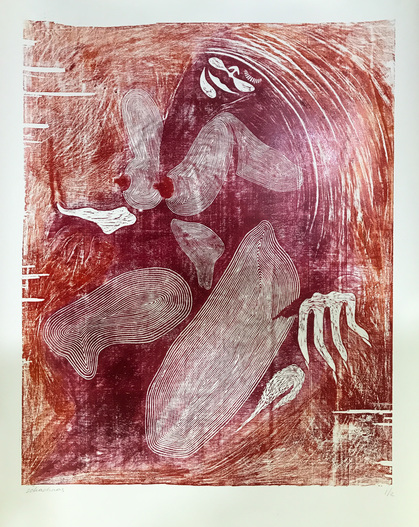-
From Current Issue
-
- Editor’s Letter Fire in the Heart
- Reviews I Gusti Ayu Kadek Murniasih
- Reviews 11th Seoul Mediacity Biennale: “One Escape at a Time”
- Dispatch Networked China
- One on One Monira Al Qadiri on Yukio Mishima
- Essays The rise of independent art spaces in pandemic-era Shanghai
- Features Tuan Andrew Nguyen
- Table of Contents
- Web Exclusives
- Archive
- Subscribe

R
E
V N
E
X
T
Detail of SAULE DYUSSENBINA’s Floral Ornament II, 2020, print, 50 × 50 cm. All images courtesy the artist and Sapar Contemporary, New York.
Alienated Bodies in “Emerging Voices: Stories from Isolation”
It is when we are sick that we become most aware of our bodies. Disease reminds us that we are ultimately just conglomerations of tissue and bone, easily undone by an infection or a cell mutation. This morbid thought is elicited by Saule Dyussenbina’s wallpaper-inspired print Floral Ornament II (all 2020), in which butterflies flit among twisting stems that sprout pink brains, hearts, and lungs along with red cabbage roses. Presented in Sapar Contemporary’s online exhibition “Emerging Voices: Stories from Isolation”—with works produced in lockdown by artists from Kazakhstan, Azerbaijan, and Georgia—Floral Ornament II reflects, in Dyussenbina’s words, how contagion-induced seclusion and “a feeling of helplessness in the face of the cruel insuperability of death have become like habitual wallpaper in our lives.”
Curators Salima Sarsenova and Zhanna Guzhavina paired the print with Dyussenbina’s aesthetically similar Qazaq Roulette Ornament, a repeating pattern of a sheep’s head, a Kazakh delicacy, with a radius of bones, a horn, a hoof, and the same human-like internal organs from Floral Ornament II. In this juxtaposition one sees not a collision of cultures (Dyussenbina typically portrays Central Asian imagery in Western idioms) but of species; the human body is no more exalted or invulnerable than an animal carcass or short-lived blooms.
The fragmentation and abstraction of the body is a recurring theme, seen for example in Shahnaz Aghayeva’s woodcut print Liberation, of a nude female figure whose torso and thighs are rendered as concentric shapes reminiscent of the loops and ridges of a fingerprint. Likewise, Aziza Shadenova’s portrait Girl depicts a flame-haired figure obscured by an exploding jade vase, its red-accented shards entwined with ribbons of yellow. Overlaying the girl’s face like a wimple or veil is a black outline of an enlarged eye, dripping pearlescent tears into two bottles on either side of the figure. In her text, Shadenova recounts feeling “peaceful on the outside but excited and agitated on the inside.” This anxiety is projected in reverse in Girl, where the semi-abstracted body maintains a sense of solidity and wholeness in contrast to the violently disintegrating vase. The artist notes the cathartic aspect of her quarantine practice: “painting the motion of destruction has made me very collected and calm.”
Both Shadenova and Maka Batiashvili capture the claustrophobic tenor of lockdown through the rendering of familiar objects as strange. Notably, both depict in vividly corporeal ways the iconic pomegranate, variously associated with fertility, abundance, and nationhood across Central Asia and the Caucasus, and emblazoned in the avant-garde imaginary by Soviet filmmaker Sergei Parajanov’s The Color of Pomegranates (1969), on the Armenian bard Sayat-Nova. Shadenova paints the fruit exploding over an ashtray, with a yellow wisp of smoke from a lit cigarette snaking through the blood-red pulp, while Batiashvili’s canvas Laughing Pomegranate shows the orb with a chunk gouged into a disturbing rictus.
Indexical traces of the body appear in Berkin & Mika’s Recurring Event, a composite of five photographs of assorted objects and a handwritten note. The clinical images of cigarette butts, a pillow imprinted with makeup, and used tissues (“it’s ok to cry” explains the note) flatten the embodied experience of quarantine ennui into signs of coping mechanisms. In contrast to the duo’s highly stylized photographs of colorful set pieces, occasionally featuring Mika Barny as model, Recurring Event captures the objects against the same mustard-yellow background to evoke a sickening blandness.
Traversing diverse mediums and iconographies, the artists in the exhibition express a charged physicality and presence in their work at a time of heightened awareness surrounding the limitations of the body, both in terms of our vulnerability to illness and of external restrictions on movement. In their representations of warped surroundings and interior disarray, the artists encapsulate the sense of ruptured normalcy that defines our disorienting present.
Ophelia Lai is ArtAsiaPacific’s associate editor.
“Emerging Voices: Stories from Isolation,” co-organized with Baku’s Tardino 6 Art Platform and Tbilisi’s Project ArtBeat, is on view at the website of Sapar Contemporary, New York, until September 28, 2020.
To read more of ArtAsiaPacific’s articles, visit our Digital Library.









